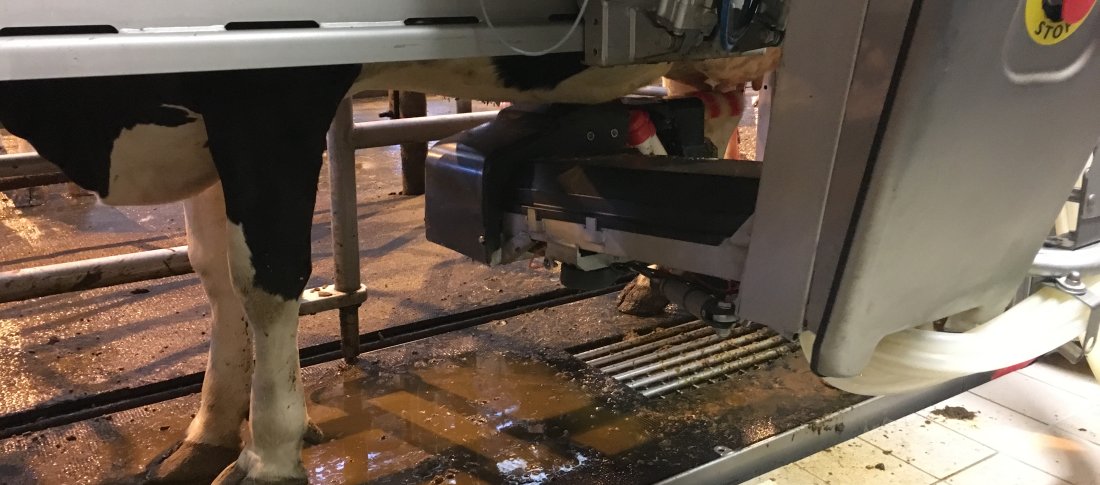What is robotic milking?
Milking cows with robots, obviously. But stop imagining your stock sci-fi film robot bumbling around your milking parlour. Robotic milking is done via small automated machines, not dissimilar to the milking machinery you most likely use already.
How popular is it?
Robotic milking systems has been commercially available since the early nineties. Yet thanks to increasingly reliable systems the technology is now undergoing something of a growth period with installations on dairy farms across the globe.
Around 2% of dairy farms in the US are now using robotic milking systems. That number is over 30% in the Netherlands, where Lely, one of the biggest manufacturers of robotic milking systems, is based. Lely anticipates growth of between 10% and 15% over the coming years.
Okay, so how does robotic milking work?
There are several different types of robotic milking systems. But broadly speaking the process runs thus. Your cow enters a small pen, driven by the desire to relieve udder pressure and nibble on the food that’s on offer during milking. As the cow enters the pen, an ID tag is scanned that tells the system when the cow was last milked, how the udder is shaped and the rate at which each teat dispenses milk.
Robotic arms simultaneously sanitize and stimulate the teats, prompting the cow to let down her milk. Lasers then guide suction tubes onto each teat and the milking begins. (If you’re interested, you can find out about the process in more detail here.)
Cows seem to be into it...
As you already know, cows don’t like change. Consistency is what gives them comfort. That explains why many dairy farmers report that - after a period of readjustment - cows seem to be calmer and happier with robotic milking. They can choose when they are milked and the process is identical each and every time. No frenzied herding into the parlour. No stress. No worries.
That’s good news for your milk yields
Happy cows are far more likely to reach their maximum milking potential. That’s great news for your profits. What’s more, the simple fact that cows can milk whenever they wish seems to enhance production. After installing their robotic milking system, Stensland Farms in Iowa saw their milking rate grow from an average of two per day to three per day - resulting in an 8% increase in milk production.
What’s actually in the white stuff?
Of course, it’s not just milk yield that affects your profits. The quality of your milk matters too. And the good news is that as they are drawing the milk, robotic milking systems test milk quality, fat content, protein content and even white blood cell count. If the milk isn’t good enough for humans, it gets separated so calves can have it instead. It’s a simple way to ensure that the white stuff is full of the right stuff.
Gather data on the health of your herd
We said it before, we’ll say it again. There are several different types of robotic milking systems. But some incorporate wearable technology that tracks all kinds of health and behavioural metrics in each of your cows. Kind of like a Fitbit for cowkind. You can monitor each cow’s step count, food intake, rumination and lots more. You can even use the data to detect when each cow is in heat to boost the chances of healthy pregnancies. This data is sent to a portal that you can access via smartphone or laptop. It makes it easy to spot anomalies that may suggest a cow is unwell, so you can take action before problems develop.
Enjoy some rest...
Yikes. Milking your herd is incredibly labour intensive, isn’t it? Finding the staff to help you in the parlour day in, day out is a struggle. With robotic milking systems that issue is taken off your hands completely. The milking is done for you. That reduces your labour costs and leaves you with more time to concentrate on other areas of your business. Whisper it, but you might even be able to treat yourself to some well-deserved downtime.
Is it for you?
Robotic milking systems aren’t every farmer’s cup of cocoa. Some are reluctant to relinquish control of such a core aspect of the business. Others are deterred by the - admittedly high - financial cost. Yet there’s no doubt that robotic milking systems are here to stay. And for increasing numbers of dairy farmers the promise of increased yields, enhanced milk quality, reduced labour and improved cow welfare is too good to resist.
You may also be interested in:
>> What funding is available to help dairy farmers invest in technology?
>> How new technology is transforming dairy farming
>> Quality in, quality out: How to get peak productivity from your herd
